Fujifilm X-H2 Review
Fujifilm X-H2 Introduction
Fujifilm revived the hybrid X-H series in 2022 with a pair of nearly identical models, the X-H2 and X-H2S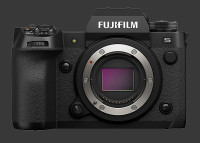
Fujifilm X-H2S. These two Mirrorless Digital Cameras are externally identical yet use two different 5th-generation APS-C sensors. The X-H2 reviewed here is built around a new 40 megapixels X-Trans CMOS 5 HR sensor, while the X-H2S offers a faster 26 megapixels X-Trans CMOS 5 HS sensor. The trade-off is classic resolution versus speed compromise which gives the X-H2 enough resolution to capture 8K video.
The Fujifilm X-H2 sports the highest resolution of any APS-C digital camera. Its 40 megapixels X-Trans CMOS 5 HR sensor is mounted on a state-of-the-art 5-axis image-stabilization system which compensates for up to 7-stops of shake. This high-resolution sensor uses a 6x6 pseudo-random color-filter-array which allows it to omit an anti-alias-filter without becoming susceptible to moire. The X-H2 has a standard ISO 125-12,800 sensitivity range which expands to ISO 64-51200.
A new hybrid shutter makes its debut on the Fujifilm X-H2. Mechanically, it handles shutter-speeds between 1/8000s and 15 minutes. Electronically though, this is the faster shutter ever built into a digital camera. It can reach a minuscule 1/180000s, fast enough to freeze hummingbird wings! Bulb mode supports exposures of up to one hour. With its large files, the maximum continuous drive speed of the X-H2 at full-resolution is 13 FPS. A 1.3X crop mode supports 20 FPS when 13 FPS is insufficient.
A 425-Point Hybrid Phase-Detect autofocus system allows this mirrorless to focus down to -7 EV. By using a powerful X-Processor 5, the X-H2 is able to track a wide variety of subjects. This camera also supports automatic Focus Stacking, Face-Detection and Eye-Detection.
This makes the X-H2 a highly-competent digital camera. What makes it stand out even more though are its video capabilities. It is the only Fujifilm camera capable of recording 8K video. 6K video is also supported by the X-H2 and X-T5. Both are recordable at 30 FPS, while Cinema 4K and 4K Ultra-HD can be captured at 60 FPS. Cinema 2K and Full HD capture is possible at 240 FPS.
The Fujifilm X-H2 is a sturdy camera with a huge number of external controls, including dual control-dials, an 8-way joystick and 10 customizable buttons. The body of the camera is weatherproof and freezeproof down to -10C. There is a large 5.8 megapixels 0.5" EVF with 0.8X magnification, 100% coverage, 120 FPS refresh and an essential Eye-Start Sensor. A 3" rotating LCD display shows one clear compromise in favor of video. A secondary monochrome status LCD is available on top of the camera.
Extensive features rounds off this mirrorless camera. Among its numerous capabilities are HDR capture, extensive bracketing options, an Interval-Timer, Panorama and Multiple-Exposures. The X-H2 comes with asymmetric memory-slots, one accepts SDXC UHS-II cards, while the other takes CF Express Type B. The highest quality video modes and maximum burst rates require a CF Express Type B memory-card.
This camera review analyses the capability, usability, performance and image quality of the Fujifilm X-H2.
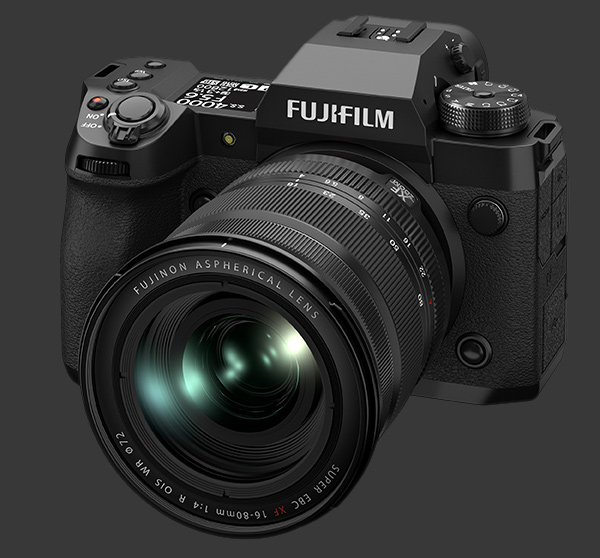
Fujifilm X-H2 Features
Sensor
- 40 Megapixels CMOS 5 HR sensor
- X-Trans 6x6 Color-Filter Array
- No Anti-Alias filter
- 1.5X Crop factor (APS-C)
- 3:2 Aspect ratio
- 100%, 200% or 400% Dynamic-Range
- Dynamic-Range Priority mode, 2 levels
- Builtin Image-Stabilization:
- 5-Axis
- 7-Stops efficiency
- Dual IS mode
- Fuji XF lens mount
- Dust-Reduction
Exposure
- ISO 125-12800 standard sensitivity, 1/3 EV steps
- ISO 64, 25600 and 51200 expanded sensitivity
- Auto ISO, Selectable maximum from 400 to 12800
- ISO Bracketing, 3 frames, 1/3-1 EV steps
- Hybrid Shutter:
- Mechanical: 1/8000s-15m
- Electronic: 1/180000-15m
- EFCS: 1/8000s-15m
- Mechanical + Electronic mode
- EFCS + Mechanical mode
- EFCS + Mechanical + Electronic mode
- Bulb exposure, maximum 1 hour
- Shutter-Speed Steps: 1/3 EV
- PASM Exposure modes
- Multi-Segment, Center-Weighed, Average, Spot metering
- Exposure-Compensation, ±5, 1/3 EV increments
- AEB, 9 frames, 1/3-3 EV increments
- Dynamic Range Bracketing, 3 fames
- Auto HDR 800%+ Dynamic Range
- Pixel Shift Multi-Shot, 1s, 2s, 5s and 15s delay
- Front or Rear Flash Sync
Image Parameters
- AutomaticAuto, White or Ambience Priority, 7 presetsSunny, Shade, 3 Fluorescents, Incandescent, Underwater, Kelvin and Custom WB
- WB Fine-Tuning along 2 axis in 19 steps
- WB Bracketing, 3 frames, 3 step sizes
- Film Simulation: Provia, Velvia, Astia, Classic Chrome, Pro Negative Hi, Pro Negative Standard, Classic Negative, Nostalgia Negative, Eterna, Eterna Bleach Bypass, Acros, B&W, Sepia
- Film Simulation Bracketing, 3 frames
- Adjustable Color, Sharpness and High ISO Noise Reduction, 9 steps each
- Adjustable Highlight Tone and Shadow Tone, 13 steps each
- Adjustable Clarity 11 steps
- Optional Chrome Color Effect
- Optional Chrome Color Blue Effect
- Optional Skin Smoothing, 2 levels
- Optional Lens Modulation Optimizer
- Optional Long-Shutter Noise Reduction
- Optional Grain Effect, 2 levels x 2 grain sizes
Focus
- Single-Shot or Continuous AF mode
- Single-Point, Zone or Wide AF selection
- Fine-Tunable Tracking AF-C:
- Tracking Sensitivity, 5 levels
- Speed Tracking, 3 levels
- Zone Switching, Auto, Center or Front
- Manual-focus (MF), Electronic Magnification
- Hybrid 425-Point Phase-Detect AF system
- Focus Bracketing: 2-999 Frames, 10 Steps, 0-10s Interval
- Optional DMF mode
- Optional Pre-AF
- Optional Digital Split Image
- Optional Digital Microprism
- Optional Focus Peaking
- Optional AF-Assist lamp
- Optional Face-Detect or Eye-Tracking
- Optional Subject Detection: Animals or Vehicles
- Optional Range-Limiter, 1 custom, 2 presets
- Fly-By-Wire focus-ring on most lenses
Drive
- Continuous Drive:
- 13 FPS, Electronic: 1000+ JPEG or RAW
- 15 FPS, Mechanical: 1000+ JPEG or RAW
- 20 FPS, Electronic: 1000+ JPEG or RAW @ 30 Megapixels with 1.3X Crop
- HDR, 3 Frames, 800%+ Dynamic-Range
- Motion Panorama, Normal or Wide, 4 Directions
- Interval Timer:
- 1s-24h Interval
- 1-999 Frames
- 0m-24h Delay
- Optional Exposure-Smoothing
- Multiple-Exposure, 2 frames, 4 blend modes
- Self-timer, 2s or 10s
Video
- 8K: 7680x4320 @ 30 FPS (16:9)
- 6.2K: 62403510 @ 30 FPS (16:9)
- Cinema 4K: 4096x2160 @ 60 FPS (17:9)
- 4K Ultra-HD: 3840x2160 @ 60 FPS (16:9)
- Cinema 2K: 2048x1080 @ 240 FPS (17:9)
- Full HD: 1920x1080 @ 240 FPS (16:9)
- MPEG-4 or Quicktime H.265
- 720 Mbps maximum bit rate
- Built-in Stereo Microphone:
- 20 Gain Levels
- Optional Level Limiter
- Optional Low Cut Filter
- Optional Wind Filter
- Stereo line-in mini jack
- Stereo line-out mini jack
- Time Code track
- Time Code over HDMI
Display & Viewfinder
- Built-in 0.5" EVF:
- 5.8 Megapixels
- 0.8X Magnification
- 100% Coverage
- Eye-Start Sensor
- Adjustable Color Saturation, 11 levels
- Adjustable Color Balance, 2 axis, 11 steps
- 3" Rotating LCD:
- 1.6 Megapixels
- Adjustable Color Saturation, 11 levels
- Adjustable Color Balance, 2 axis, 11 steps
- Touchscreen
- 1.28" Monochrome Status LCD, 128x128
- Digital Level, 2-axis
- Depth-Of-Field Preview
- Optional Live-Histogram
- Optional Framing Guidelines, 3 types
Output Processing
- 3:2 Native aspect ratio
- 16:9, 4:3, 5:4 and 1:1 cropped aspect ratios
- 40, 20 and 8 megapixels uncropped modes
- JPEG, HEIF, RAW, RAW+JPEG capture
- 2 JPEG Compression levels
- 3 RAW Compression modes
Misc
- Dual Control-Dials
- 8-Way Focus Joystick
- 10 Customizable Buttons
- Standard Hot-Shoe & Sync-Port
- 2.5mm Wired-Remote Connector
- 3.5mm Stereo Input
- 3.5mm Stereo Output
- 8K 10-bit HDMI Output
- USB 3.2 Type-C
- WiFi 802.11ac
- Bluetooth 4.2 LE
- Cf Express Type B Slot
- SDXC UHS-II Slot
- Lithium-Ion battery
Fujifilm X-H2 Capability - What can it do?
As a co-flagship Hybrid Mirrorless Camera, the Fujifilm X-H2 boasts extensive photography and videography features. When we reviewed the X-T4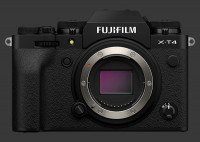
Fujifilm X-T4, it looked like the X-H series had been abandoned given that advanced video features were added to that flagship model. Now that the X-H2 and X-T5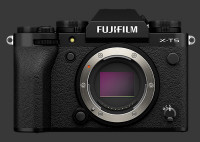
Fujifilm X-T5 were released, built upon the same sensor, the differentiation between photography and hybrid models became clearer. It mostly comes down to heat management to sustain video capture longer.
Almost every advanced photography feature is available in this mirrorless. There are full manual controls with an extreme exposure-latitude. The total sensitivity range spans ISO 64-51200, while timed shutter-speeds from 1/180,000s to 15 minutes area available, plus Bulb exposures up to a full hour. It can freeze the fastest motion of any digital camera and capture long light or star trails. The fastest mechanical shutter-speed is 1/8000s. The electronic shutter can cover the entire shutter-speed range except for Bulb mode.
All standard PASM modes are available and there is a choice of 4 metering patterns: Multi-Segment, Center-Weight, Spot or Average. Exposure can be adjusted ±5 EV in 1/3 increments. Aperture can also be set in 1/3 increments which corresponds to the aperture-ring detents on Fujinon lenses. Even standard ISO sensitivities can only be selected in 1/3 stops, with additional expanded options in 1/3 or full-stops. Notice this is one of only high-end digital camera which does not offer at least ½ EV increments.
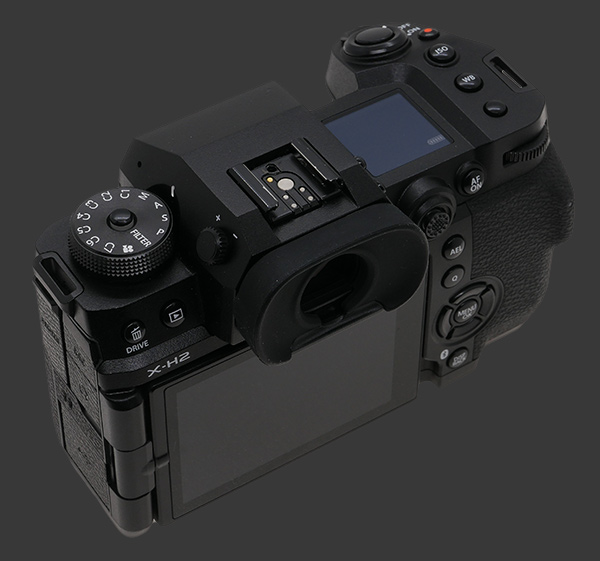
Fujifilm cameras offer plenty of image parameters. White-Balance control include 2 Auto variants, 7 Presets, Kelvin and 3 Custom settings. All are fine-tunable in 19 steps along 2 axis. Additionally, Virtual WB Bracketing can save 3 images with different WB fine-tunning. There are 3 step sizes to choose from along the Y-B axis. Image rendition is based around Film Simulation modes with a number of parameters to adjust JPEG or HEIF output. Color, Sharpness and Noise-Reduction are each adjustable in 9 fine steps. Shadow-Tone and Highlight-Tone adjustments are selectable in 13 levels. There is a Clarity control which provides 11 levels of additional processing. This is very resource intensive and impacts camera performance, more on this in the Performance page of this review.
Bracketing modes on the Fujifilm X-H2 are outstanding: Auto Exposure Bracketing, ISO, Film Simulation, WB, Dynamic-Range and Focus. AEB can capture from 2 to 9 frames with steps from 1/3 to 3 EV, selectable in 1/3 increments regardless of how many frames are selected. A bracket can be taken continuously or by single-shots with four ordering to choose from. ISO, Film Simulation, White-Balance and Focus all capture 3-frames. Focus Bracketing is class-leading with an Auto mode that captures an unspecified number of frames with a delay of 0-10s between frames. In Manual Focus Bracketing mode, this camera takes between 1 and 999 images with 10 possible increments and a 0-10s interval between each image. Focus Stacking of the resulting images must be performed by software. The same is true of Pixel Shift capture which takes 20 frames that can be assembled into a 160 megapixels image.

Drives modes of the Fujifilm X-H2 are quite extensive with many have several variants. Continuous drive modes from 3 to 15 FPS are available whiling using the mechanical shutter, while the electronic shutter limits the burst-rate to 13 FPS at full-resolution. With a 1.3X-crop, resulting in 30 megapixels images, up to 20 FPS is supported. In all cases, the incredible throughput of this camera can handle bursts of over 1000+ JPEG, HEIF or RAW files! There are 5 HDR modes: Auto, HDR 200%, HDR 400%, HDR 800% and HDR Plus to capture more than 800% Dynamic-Range. Sweeping Panorama, Multiple Exposures, with 4 blend modes, Pixel Shift, Self-Timer and an Interval Timer complete the remaining Drive modes other than Bracketing.
Image-stabilization of the X-H2 is the most powerful one from Fujifilm. Its 5-axis image-stabilization system can compensate for up to 7-stop of shake, more than nearly every other system and a significant upgrade from previous generations. This is a huge deal since in-body stabilization benefits all lenses, including those with no stabilized equivalent such as ultra-fast prime lenses.
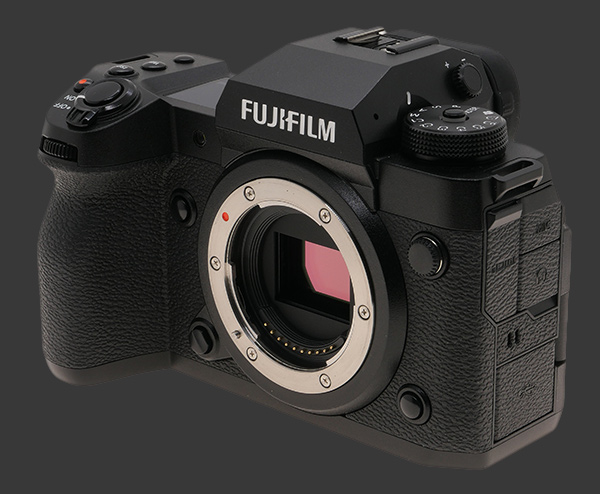
The 40 megapixels APS-C X-Trans CMOS 5 HR sensor of this mirrorless incorporates a 425-Point Phase-Detect AF system. It can focus down to -7 EV which is very dark. This autofocus system is highly configurable and is designed to track a wide variety of subjects in real-time. It is possible to focus nearly anywhere in the image. In Manual Focus mode, the X-H2 boasts 4 assistive technologies: Focus Peaking, Digital Microprism, Digital Split Image and standard MF-Assist.
This brings us to video features of the X-H2, the most video-capable Fujifilm mirrorless yet. Its headline feature is certainly 8K video capture which it can do between 24 and 30 FPS. 8K video is compressed using the high-efficiency H.265 codec. Just for 8K, there are 7 formats to choose from, all stored in a Quicktime wrapper yet with 10-bit pixel-depth. Depending on the selection, a bit-rate can be selected between 50 and 720 Mbps. All-Intro modes for efficient editing are available. There are exactly the same options for 6.2K recording. At 4K, four additional formats are available, including 8-bit encodings. High-Speed recording to create up to 10X slow-motion video is available when filming Full-HD video. Note that due to bandwidth requirements, some video formats and encodings are only available when recording to CF Express Type B cards.
Audio recording with videos can be configured independently of the video format. Both the builtin stereo microphone and line-in have an adjustable level between -30db attenuation and +6db amplification. The input mini-jack can distinguish between a direct microphone and line input. On-boars audio processing can apply a Level Limit, Wind Filter and Low-Cut Filter. An optional XLR adapter allows an additional stereo stream to flow into the camera. Uniquely, the X-H2 allows the camera to record from XLR only or 4-channel sound by using the XLR input and the camera stereo input simultaneously.
Numerous auxiliary features and an absolutely outstanding number of customization options exist on the Fujifilm X-H2. Notable, the camera has 802.11ac WiFi and Bluetooth 4.2 LE builtin, a Sync-Port, a Standard Hot-Shoe and a Full-Size HDMI port. Up to 8K can be output but not under any circumstances. It is possible to use the HDMI port to record externally without consuming memory-card space.
 |
Please Support Neocamera
All information on Neocamera is provided free of charge yet running this website is a huge endeavor. Purchases made via affiliate links found throughout the site help keep it running and up-to-date. There is no additional cost to you, so please consider buying via these links to our affilates:
Thank you for your support!
Fujifilm X-H2 Highlights

Sensor-Size: 24 x 16mm

Actual size when viewed at 100 DPI
| 40 Megapixels Mirrorless | ISO 64-51200 |
| Fujifilm X Mount 1.5X FLM | Shutter 1/180000-900s |
| 5-Axis Built-in Stabilization, 7-Stop Improvement | Full manual controls, including Manual Focus |
| 0.50" Built-in EVF 5.8 Megapixels (0.80X) | Custom white-balance with 2 axis fine-tuning |
| Automatic Eye-Start sensor | Spot-Metering |
| 2 Axis Digital Level | Hot-Shoe & Sync-Port |
| Weatherproof down to -10C | Stereo audio input |
| Built-in Dust Reduction | Lithium-Ion Battery |
| 13 FPS Drive, 1000 Images | CF Express Type B, Secure Digital Extended Capacity |
| 7680x4320 @ 30 FPS Video Recording | |
| 3" LCD 1.6 Megapixels |
Updates
2025.11.13

Best Gifts for Photographers in 2025 by Budget
The annual Neocamera Photography Gift Guide updated to 2025. Find great gifts for photographers with any price budget.
2025.07.07

Stellar Photo Recovery Review
Review of Stellar Photo Recovery V12. This Windows and MacOS software can recover photos and videos in a huge number of formats from memory cards, USB drives, SSDs and HHDs.
2025.05.14

Huion Kamvas 13 Gen 3 Review
In-Depth review of the Huion Kamvas 13 Gen 3 Pen Display Tablet for photographers and graphic artists.
2025.01.18

Fujifilm GFX 2025 Lens Roundup
Lens Review roundup of Fujifilm GFX Medium-Format lenses. Quality, performance and handling of the GF20-35mm F/4R WR, GF30mm F/3.5 Tilt-Shift and the GF55mm F/1.7.
2024.11.18

Best 2024 Photography Gifts for Every Budget
Great gifts for photographers and photo enthusiasts selected for every budget among the best products of 2024.
2024.08.07

Eye Protection Tips for Professional Photographers
The four main considerations for professional photographers regarding eyewear.
2024.07.14

Fujifilm X100VI Review
Flagship fixed-lens compact digital camera with a 40 MP sensor and Image-Stabilization, a first for the series. Retro design featuring dual control-dials, plus direct ISO, Shutter-Speed and EC dials. Its hybrid viewfinder can switch between EVF and OVF mode.
2024.05.09

Fujifilm GFX100 II Review
Flagship 102 Megapixels Medium-Format Mirrorless Digital Camera with 8-Stop 5-Axis IBIS, 8 FPS Drive, 8K Video and 400 MP Super-Resolution capture in a weatherproof and freezeproof body with dual control-dials and dual memory-card slots.
2024.04.03

Fujifilm X-T5 Review
Newest Fujifilm flagship boasting a 40 MP APS-C sensor, 5-axis IBIS with 7-stop efficiency, 15 FPS continuous drive, 6.2K Video capture, dual control-dials and dual SDXC UHS-II slots in a sturdy weatherproof and freezeproof body.
2023.11.20

Best Digital Cameras of 2023
Find out which are the Best Digital Cameras of 2023. All the new Mirrorless Digital Cameras from entry-level to high-end professional.
2023.07.10

Fujifilm X-H2 Review
40 Megapixels APS-C Hybrid Mirrorless Digital Camera with 7-stop IBIS. Fastest shutter ever and 8K video capture. Large builtin EVF with 0.8X magnification and 5.8 MP, plus an Eye-Start Sensor. Packed with features and large number of controls in a weatherproof and freezeproof body.
2023.05.07

Sony FE 20-70mm F/4G Review
Review of the unique Sony FE 20-70mm F/4G lens. The optical zoom of this lens spans ultra-wide-angle and medium focal-length coverage, making it one of the most versatile Full-Frame lenses on the market.











